Estate of grace
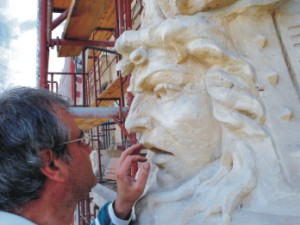 Luxury interwar villas are the ideal residence or place of work for everyone who comes to stay in the capital. Anca Pol and Michael Bird explore the cost of restoration Luxury interwar villas are the ideal residence or place of work for everyone who comes to stay in the capital. Anca Pol and Michael Bird explore the cost of restoration
Early in the last century Bucharest experienced a building boom of residential villas. A consortium of internationally-trained architects transformed the city into a maze of leafy avenues housing eclectic and individual villas. During Communism many of these houses fell into disrepute due to state acquisition.
They were separated into different units, rented to families or transformed into offices. Few had the time, will or cash to maintain the peculiar beauty of the capital's architectural heritage.
In the last decade however, a wave of speculators has seen the potential in this estate. For those who consider property as the ideal investment, these buildings have offered a possible money-spinner. The new rich are paying what it takes to live in the most exclusive properties, while small companies in sectors such as advertising, consultancy and law are willing to pay high rents to work inside a status symbol.
“People are attracted to the inter-war period because it is allegedly the best period in Romania's history,” argues Eduard Uzunov, real estate firm Regatta's general manager. “These buildings are now filled with 'an aura of prestige'.”
Competitor Eurisko says customers are looking for styles that reflect the European evolution of architecture and decorations, generally those exhibiting French, German, Italian and Oriental influences.
High ceilings, spacious rooms and quality materials used to build such villas make these desired properties, argues CB Richard Ellis's corporate director Edit Vesser, “as well as the possibility of transforming a classical villa with a modern design into a unique product that truly represents the current 'chic' architectural style of the 21st century.”
However there is a low supply of such houses, therefore prices stay high.
“Most of the clients are investors, both Romanian and foreign,” says Anne Marie Panculescu, project manager, residential for sale department, Eurisko. “Investors are buying classical villas before they are renovated.” Following this, they pay to restore the original architectural style, before putting it up for resale.
But Uzunov argues that these prices are still lower than in other European capitals.
“If we were to compare the prices in the 'little Paris' with the prices from the real Paris, those for apartments in the most prestigious areas can reach 10,000 to 12,000 Euro per sqm,” adds the Regatta general manager. This compares to a maximum of around 2,000 Euro per sqm in Bucharest.
Location is everything, of course.
“For these type of properties you pay not for the house in itself, but for the area where is located and for the architectural value of the estate,” says Panculescu.
She adds that in 2004, the amount of 500 Euro per built sqm was considered a high price for such villas. But today these prices have doubled and are even more, for non renovated villas.
Specialist in the sector David Howe, in-house lawyer at Investmentromania. com says that it is probably worth buying such a classic villa.
“But only in a villa area. Not one that is between blocks and higher buildings,” he adds.
ROOM TO RENT
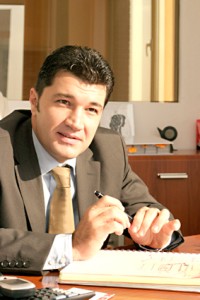 However there has been a recent change. Before these were seen as an investment to rent to a firm or an embassy. However there has been a recent change. Before these were seen as an investment to rent to a firm or an embassy.
“Currently villas that were restored are no longer favoured for renting,” says Panculescu. “The rent-final price report (including the acquisition price and renovation costs) is less attractive than during the last years.”
In 2004, 95 per cent of the target market for leasing residential space was to foreigners, those who work in embassies or multinationals, according to Eurisko.
“As the offer is limited and the demand soaring, rent level is high,” says Panculescu.
But Vesser claims the rents for such properties are more or less staying the same and only seeing “minor fluctuations”.
For an investor in this area, it may be better bet to rent such a space for offices rather than for residential. This, David Howe argues, can see a ten to 15 per cent return, as opposed to only a 3.5 per cent return for residential.
RIGHT OF RETURN
Many of these houses are returning to their original post-1945 owners. The Government is aiming to make the process of giving back these properties to the previous owners simpler to understand and easier to complete. Whether this will occur is another matter.
Restituted villas sell quickly. People who win them back do not tend to live in them or restore them. They see to see such proposals as a source of a quick buck and sell them on to an investor, who restores the building, then ups the price. But the restitution process takes time, with many cases pending in the courts for years. This means that many buildings remain empty or in peril.
“Delaying the process of revitalisation of Bucharest's old villas has been the lack, until recently, of coherent property legislation,” argues Uzunov. “For this reason, you will see houses that are wrecks even in Bucharest's luxurious or expensive areas.”
Embassies, consulates and hospitals are now in the process of being given back to former owners before 6 March 1945. The state aims to solve all demands and litigations before 2007.
During Communism, the state separated many old villas into compartments and rented each section to a different family. After 1990, these tenants could buy the sections of the villas where they lived. In 1996, a ten year period was introduced in which they could not sell on the space. Starting next year they will be able to put each compartment they own on the market.
“Quite predictably, many such compartment owners will rush to sell them, knowing they can get a good return,” says Uzunov.
Because of this new law and the escalation of restitution cases there is a greater supply of renovated property in the historic centre, which means costs could come down.
“This will influence the market and, as more such estates will appear, the prices could diminish”, Uzunov predicts.
But Vesser says it is “too early to speculate” just what effect a general increase in supply may have on the market.
COST OF HERITAGE
There is a list of over 2,000 buildings which are part of Bucharest's heritage or patrimony.
These are listed not only for their old age, but also according to criteria such as the level of their preservation, their relevance to the history of the city and the nation, as well as the degree to which the building “embodies” a certain architectural or historical period.
Before 1990 there was no legislation regarding the protection of historical monuments. It took until 2004 for a final list of historical monuments, including Bucharest's most valuable and beautiful buildings, to be officially published.
But that does not mean that if one lives in such a building, one cannot stick a nail in the wall or mend a leaking roof. Modifications can be made. “If they do not damage the very architectural aspects which rendered the patrimony value of the building,” according to executive director, Bucharest Patrimony department of the Ministry of Culture, Stefan Damian.
As well as the kudos and value of having a 'listed building' there are also other pecuniary advantages.
“If the owner uses the building for actually living in, he or she will not have to pay property taxes,” he claims. “Also if the proprietor puts forward to the Patrimony authorities a sensible restoration work project, he or she can get financing.” But seemingly, no such case has been registered so far. Maybe this is because no one knows about it. Damian says it is because the ministry does not have the money to establish a campaign to tell everyone.
FORMER GLORY
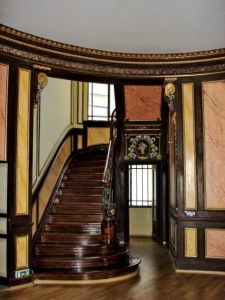 Restoration is now a massive business. This is the price of several decades where no respect was given to property. Even in the former dormitories of the architectural faculty, Dorin Danila, a specialist restorer, found that students had thrown knives and darts without a care for the heritage, damaging the classic interiors. Restoration is now a massive business. This is the price of several decades where no respect was given to property. Even in the former dormitories of the architectural faculty, Dorin Danila, a specialist restorer, found that students had thrown knives and darts without a care for the heritage, damaging the classic interiors.
“It was like being in the army,” he says. “No one cared about how they treated anything.”
Danila studied restoration in Italy and, during the last years of Communism, was among those who worked on building Ceausescu's ornate aquatic fountains on Blvd Unirii, or as he calls them: “Those stupid fish.”
Now he is at the hub of a renaissance in restoration of classic residential and public buildings. Part of this is due to foreigners coming to Romania to buy out pre-war villas.
Experienced in refilling damaged stone and discovering original stucco work, Danila finds much of his work is devoted to working on restituted properties that have been sold on to an investor.
These classic villas were often partitioned and then used for offices. His job is to discover the original material underneath the layers of paint or cement. Firstly, he uncovers a ten square centimetres in each room to gauge the number of layers. “Often in former nationalised buildings, they have painted over original wallpapering several times,” he says. “Sometimes there are seven layers of paint, in white, green or blue, up to three mm thick.”
Most of these properties have naked interiors: state and 'private' owners had taken the bronze fittings and fireplaces and sold them on. This is hard and costly to replace. Usually Danila changes the floor, unless it is a special design feature, as well as all the electricity and heating facilities.
To renovate a property in Bucharest it would costs around 250 Euro per sqm, says lawyer David Howe, while to restore a property this can costs from 400 Euro to whatever one is willing to pay.
“Especially when bringing in new paintings and restoring the original character it is a case of: how much do you want to spend?” says Howe.
Architectural salvage is also very expensive. Howe says a 1.5 million villa in the northern district, for example, could cost a further 400,000 Euro to restore.
But the returns could be worth it.
“If you buy a house like this, you can invest 1.5 million and can sell at after restoration for around three million Euro,” says Danila. “If you want to restore and sell it's a good business. It's cheap to invest here.”
But with such properties, there are risks, and a survey of a renovated or unrestored property is essential.
“As with any 100 year old house: there needs to be damp-proofing, the foundations may need underpinning,” says Howe.
“If a restoration has been done, it may only be cosmetic, with no structural renovation. So it could fall down in an earthquake.”
Sometimes these properties need a new roof and, with the buildings that belong to the Romanian patrimony, restrictions can exist.
But restoration does take a long time. “You will have to wait. Many could be discouraged because there are a lot of files,” says Danila, “if you want it to be legal.”
|
| Beware the law |
Foreigners can buy buildings, but not land until after 2007. In order to purchase the land on which the building resides, a third Romanian individual or company buys the land. This looks like a decent investment. However, if a foreign investor is then choosing to restore and sell on the property, the returns are not that good. “This is because the company, not the individual, is selling on the land, which means this cost is subject to VAT,” David Howe, lawyer at Investmentromania.com says. Currently this tax is at 19 per cent, so a three million Euro sale must include 600,000 Euro sent to the taxman. Up to 50 per cent of the sale price could be eaten up by taxes, which include stamp duty, property tax, capital gains tax (16 per cent) and notary fees. This is the case unless the foreign investor chooses to sell the property a company, which can then ask for the VAT back. |
|
Capital growth
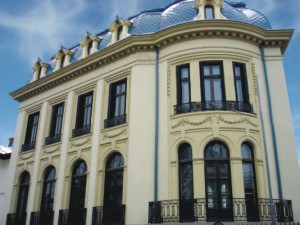 After a boom in the housing market in 2004, where capital gains soared by 40 per cent, the market is settling. Now it is more visible where the low and high quality properties are, as well as the good and bad locations. After a boom in the housing market in 2004, where capital gains soared by 40 per cent, the market is settling. Now it is more visible where the low and high quality properties are, as well as the good and bad locations.
NORTH
Top areas include Herestrau, Baneasa, Floreasca, Primaverii and Dorobanti. This is where the highest demand for villas exists. Along with Cotroceni in the west, this constitutes 80 per cent of demand for luxury villas, according to Eurisko. These are mostly 1930 to 1940s houses. In Baneasa, there is a building boom for new luxury villas. Along Unu Mai, starting from Piata Victoriei, lawyer David Howe says prices will not drop.
EAST
Communist era flats in the Dristor area have seen a collapse in price this year. The old pre-fabricated blocks have dropped by 30 per cent in value, says Howe. “There is probably not a big future for these kind of buildings,” he says. Cheap to build, quick to construct, this could seem like a cost-effective investment to some, at 50,000 Euro for a family home in a capital city. But this could turn into a money pit. Little cash has been spent of maintenance and aesthetically the constructions are pretty miserable. Such a phenomenon happened in East Germany, where some of the buildings are close to tumbling down. And in Bucharest, one has to add the threat of earthquakes.
CENTRE
Top areas include Rosetti, Unirii, Lipscani and Cotroceni. Here there is a high demand for interwar villas, as well as 19th century houses. Edit Vesser, CB Richard Ellis Romania says the district near Piata Universitatii has seen increased interest. This includes the historical centre of Bucharest, which is undergoing a much delayed development. This will see a retail boom. But Vesser warns that the legal status is highly uncertain. “Once the legal status is clarified and the area developed, which could take a long time, the properties within this area will become a main target, and influence the prices upward,” he adds. The Lipscani area has different houses built from the 1760s to the near-present. These have basement areas with black volcanic stone often in disrepute, says restorer Dorin Danila. There are grand courtyards in this area, while the floors above the property could be transformed into offices or maybe residences for young people. He says it is possible to keep the facades of some houses but completely renovate the backs, in some cases. Danila says that the whole redevelopment process could be finished by 2010, “but it depends on the money and the interest.” Because of the superior location and the small concentration of space in Lipscani, restored first and second floor apartments in this area could be among the most expensive properties per square metre in the capital. From Piata Unirii to Piata Alba Iulia, there are flats completed in the 1980s and 1990s that are sturdy, modern and well-kept. Howe says prices here will not drop. Regina Maria, Calea Calarasi and even Rahova, says Howe, also have potential. “They are totally underdeveloped,” he says. “But they have a lot of unresolved status of buildings: few move out, few move in.”
WEST
Some observers believe the west of the city will see the next boom. Prices around Plaza Romania have risen. Howe argues that anywhere near an underground station would be a decent purchase.
OUT OF TOWN
Buftea, Corbeanca, Balotesti and Snagov are seeing a building renaissance in new private villas. This is the bait for the middle classes who want to move out of the city. “The city will grow,” says Howe, “especially out to satellite villages: everyone will move out to the small villages in the outskirts.” |
|
What is the Bucharest style?
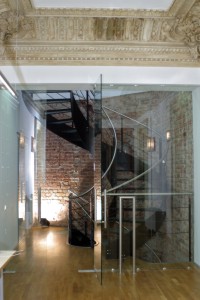 Experts tell Anca Pol what they believe makes the capital of Romania different Experts tell Anca Pol what they believe makes the capital of Romania different
Bucharest is not old.
Its name started to appear about halfway through the last millennium. Compared to Athens (pre 2000 BC) or Rome (783 BC), Bucharest is a spotty teenager.
“Unfortunately, due to various reasons like earthquakes, fires, floods, Turkish invasions, three out of these five centuries of history are not visible in historical monuments,” says architect and professor Gabriela Tabacu.
Hanna Derer, Professor at the Architecture University 'Ion Mincu' adds: “If we were to choose a single word to describe the most important quality of Bucharest from the architectural point of view, this would be, in my opinion 'diversity.”
But she says this does not mean the city is a mess. “Diversity must not be taken for a lack of homogeneity and unity,” she adds. “It's a diversity equilibrated by urban coherence.”
This means that important and busy city axes such as Piata Romana to Universitatii are alternated with a network of smaller streets with old and often beautiful buildings gathering behind the main boulevards.
FRENCH STYLE
The 19th century has given Bucharest its heritage and architectural shape. This includes the Romanian Athenaeum and the national savings bank CEC building and the History Museum [initially the home of the Central Postal service], both on Calea Victoriei. “In general, the style of these monumental buildings is eclectic, with obvious elements of French influence, which is explained by their authors' educations, most of whom studied in Paris,” says Tabacu.
NEOROMANIAN STYLE
One celebrated building is Scoala Centrala Bucuresti ( 1931), the work of Ion Mincu, the founder of the Romanian architecture school. Inspired by Wallachian folk architecture, this is a forerunner of the Neo-Romanian style. To these public buildings, smaller habitable buildings are added, like the Mincu-designed Casa Lahovary (1886). The 20th century is more visible in the Romanian capital. Its first two decades see Mincu and his followers in evidence, such as the Bucharest City Hall (Regina Elisabeta).
INTERWAR ECLECTICISM
In the 1930s, a less ornate neo-classicism was popular. A perfect example is Facultatea de Drept (School of Law) building on Blvd Kogalniceanu. In residential areas, this was present in the Florentine and the Neo-Moorish styles. “Bucharest's image is marked by a modernistic architecture of very good quality, as produced in the inter-war period and this mark has had an important say in the character of the city's centre and residential areas,” Tabacu adds.
DETAILS MAKE A CITY
Another sign of unity in Bucharest's diversity are the architectural leitmotifs one finds in the capital. This includes the shape of street corner buildings, which are not only blunt, but also built slightly higher than the buildings of the neighbouring streets, according to Hanna Derer.
Another detail is twinned buildings, either identical or mirrored buildings which adopt a train carriage style in their arrangement of windows, placed face to face on narrow land plots. One can find such a pair of twin buildings, built in the 1920s on Strada Regina Maria, close to the intersection with Bulevardul Unirii or in the area between the Universitatii area and Piata Romana, built at the turn of the last century.
Also parochial churches, which are usually placed at important crossroads, serve as bench-marks, with their high spires visible from far away (at the time when they were built). This has changed, after Ceausescu's efforts to demolish, move or hide many of them behind blocks of flats or taller buildings.
|
|